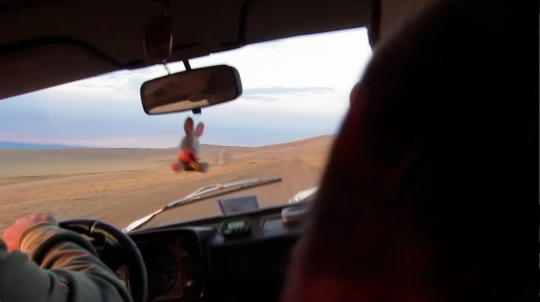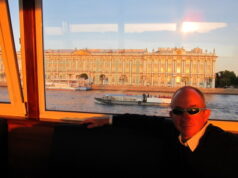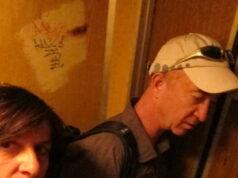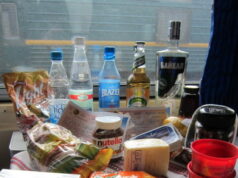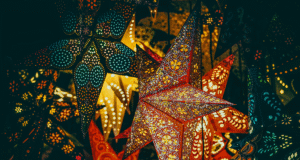A chaotic journey across half the planet by train — where bad planning collides with blind luck and sheer stubbornness keeps the story moving.
Chapter Five: Siberian Summer
Sergei Schumacher tosses his head back, flashes us a mouthful of gold teeth and lets out another chesty rolling laugh. His laugh is genuine and long lasting. He rolls it out like all good Russians roll out their “R’s”. It’s infectious and we find ourselves laughing along even when we have no clue what he just said. He laughs a lot and not just for us. The crow’s feet around his eyes and the creases on his face are testament to the excessive amount of time he must have spent laughing and smiling in his 60 odd years. I would guess that he is a very good grandfather to someone, a favorite uncle at the very least.
This last belly laugh comes after I have dubbed him “Schumacher”. It’s not far-fetched to believe there is a relationship between Sergei and Formula 1 racing’s most celebrated pilot. The controlled recklessness with which he is driving across this barren glacier-formed landscape convinces me of that. He gets the joke and laughs. Or maybe he doesn’t get it and just laughs anyway because that’s his natural state. Sergei speaks only about 10 words of English and 9 are related to cars or driving. “Your Lada, strong car!” I enthuse, tapping the dashboard ahead of me and turning my thumbs up. “Da!” says Sergei “Lada is Fiat now. Italia. ‘Horror-show’!”. ‘Horror-show’ (or something that sounds like that) means good in Russian, I have learned. “What auto is yours?”, he asks in a well rehearsed phrase.
A few hundred meters from the ferry terminal where we arrive, Sergei drives off the raised, half-finished ‘official’ road onto the braided tracks that run along-side it. As we drive down the embankment he points to the tracks ahead, thumps his chest and declares “Sergei’s Autobahn!”. Tossing an accusatory thumb back towards the raised ‘official’ road he says “That Autobahn, no Horror-show”. I’ve heard that the German’s are considering putting speed limits on their Autobahns now. There are definitely no limits on Sergei’s Autobahn. The earth is so hard and compacted in this area a car can drive in any direction. Tracks are easily formed as the minimal top growth rubs away with each passing tire. When a rut develops or patch becomes too sandy, drivers simply create a small detour for a few hundred meters and rejoin the old track or just continue on in the same general direction. The end result resembles the groomed, nearly flat trails at the bottom of a ski resort. You only ski these things at the end of the day. They have similar patterns of ruts and grooves. The skier needs to commit early to a line and stick with it. There is no room for hesitation. Indecision can be disastrous. Sergei picks his lines early and commits with the accelerator pedal. We drift and slide through turns as if on snow. I am sure we are going to catch an edge and go tumbling across this nude landscape in rapid beam-side barrel rolls. But Sergei knows his car’s limits and his own. He probably drives this 40km stretch of tracks a hundred times a week. Still, I am hoping the people form Fiat put airbags into this Lada. A roll bar would be helpful too.
Twenty kilometers later, having exhausted automotive small talk, Sergei points to a lone pine tree on a bluff overlooking the ridiculously flat waters of Lake Bailkal and shouts above the protesting whine coming from the Lada’s gear box: “Shaman Tree!”. This is followed by an unusually hearty guffaw. He raises both hands towards the ceiling of the cramped Lada and dips his head towards the steering wheel in a bowing gesture to imitate someone in prayer. I wish he’d keep a hand on the wheel and at least one eye on the ruts ahead of us. He looks up and winks. Either he has guessed what I am thinking or he is showing that he is not a real believer in this Shaman stuff. He has no shamanistic paraphernalia or statues of an orthodox saint glued to his dashboard. He does, however, have some evil looking bunny bouncing from a noose attached to the review mirror.
The shamans are the medicine men, witch doctors, spiritual leaders, gurus, monks, priests…. of the Buryat people. The Buryat are what the Mongols are called here. I am guessing that Buryat is the name of one of the dozen or so tribes that made up the Mongol nation that Ghengis Khan stitched together from a disparate group of high plains drifting nomads in the 13th century. The Buyrat where located furthest north in the Mongol nation, here around Lake Bailkal and present day Irkutsk. There wasn’t much worth conquering further north of this huge 650km (380mile) lake. It’s the deepest in the world and reputed to hold twenty percent of the world’s un-frozen fresh water. The permafrost begins just north of the lake. That land is mostly useless for farming, grazing or anything else. And it’s damn cold.
Shamanism pre-dates Budhhism, but residual pieces of its belief system are incorporated into the Mongolian/Buryat version of Buddhism. It’s a kind of animist belief system. It’s based on respect, worship, superstition, irrational belief (choose an adjective appropriate to your own level of skepticism) surrounding nature and its mystic forces. The earth is considered sacred so you don’t dig it up. Have you ever wondered why a fierce warrior tribe like the ancient Mongols wore rather dainty boots with up-turned toes? Upturned toes won’t scuff the grass or accidentally make any holes in the sacred earth. Earth, wind, fire, the sun and the moon all play leading roles in the drama. The present day Mongol flag includes representations of the moon (the father), sun (the mother) and three licks of fire representing past, future and present and also prosperity. For good measure there is also an abstract spearhead pointed downwards to represent defeat of the enemy.
The shamans also believe that certain locations on the earth have more energy value than other places. In the Buyrat’s world there are five energy hot spots and the most important is on Olkhon Island atop a small peninsula near the village where we are going to stay. Since the fall of the Soviet Union twenty years ago, religion is back in vogue and freely available to the masses. Sadly, opium is still a restricted category III narcotic. So Shamanism is back. The sacred hot spots are dotted with phallus-like poles wrapped with strips of cloth, pieces of clothing, plastic bags and the occasional Levi’s branded bandana that looks worth stealing if I weren’t a bit superstitious. These are added by worshiper/travelers and over time the final result becomes rather colorful and picturesque. The donations of the devout also provide a bit of modesty to the bare wooden phalli. Part of the worshiping tradition seems to involve making a little pile of rocks near the totem poles. Maybe a little prayer or wish is requested when the pile is put together. I suppose this is no stranger than lighting a candle and saying a prayer in church. You aren’t expected to drop a coin in the priest’s tip box but coins are still tossed around the rock piles. As we look closer, we see that the rock-pile-making tradition has evolved into something more these days. One pile is laid it out in a version of Germany’s Iron Cross. Some Taiwanese nationalist has carefully placed out a marker for his country. It’s designed, no doubt, to piss off any mainland Chinese who make it this far. Some dude named Saul professes his love for cock in a pictogram. Weird.
The Soviets, of course, had no use for this superstitious nonsense. They took this holy spot on a mostly unpopulated island and built a classic white elephant enterprise. This one took the form of a fish factory in the corner of the town’s picturesque beach. It made no sense whatsoever. The local Buryat don’t eat fish. There were no fisherman on the island and the nearest fisherman’s port was more the 200km (120 miles) away. There was no pier. There was no electricity. The Island is a 5 hour drive from the nearest consumer market or train depot to the rest of Russia. That’s on today’s road. So it was at least a day’s drive when the thing was built. So they imported everything. Concrete and steel to build the factory. Cans to put the fish in. Fish to put in the cans. Generators to create electricity. Diesel to run the generators. And when it was finally done they realized that there weren’t enough people to work the lines. So they imported the workers as well. That was the one thing Stalin had in abundance: cheap labor. So huge labor camp was created and anyone who stepped out of line in their home communes, pissed off a commissar or stole a potato from their own farms was sent to a labor camp like this.
The Soviets had other hair brained schemes running on the mainland. Rather than get the nomadic Buryat to focus on what they were good at: raising cattle and perhaps feeding the nation with much needed protein, they forced the Buryat to become farmers. This was probably a good strategy to keep tabs on the Buryat but otherwise it was a total disaster. The land is not optimal for farming. That’s probably why it’s been used for herding for the past thousand years or so. More to the point, you couldn’t ask (or force) the Buryat to do something more contrary to their nature: dig up and violate their sacred earth; plant and eat grain or vegetables; stay in one place for more than 3 months, pen in their animals…
ButiIt does seem that the Soviets were successful in finally breaking the back of the Mongol spirit, completing a mission begun by the Cossacks in 1651 when they built the first garrison in what became Irkutsk city. Sometime in the 19th century Russia and China made a deal to split up Mongolia. China took the southern third and called it Inner Mongolia. Russia took the northern third which included Lake Bailkal and the Buryat. They left the middle third as a kind of buffer zone but that fell under Soviet influence by the mid 1920’s. Today, a few spirited Mongols of Inner Mongolia agitate and talk about re-uniting Inner Mongolia with the rest of the Mogolian nation. You won’t hear about much if the Chinese continue to have their way, but there is a movement. Just a few years ago one ‘wanted’ activist escaped to Ulaan Baatar seeking asylum from his brother Mongols. Political expediency didn’t work in his favor and the government turned him over to the Chinese who executed him or threw him into a dark cell somewhere to rot. Perhaps we should give him a Nobel Peace prize or something. That will teach the naughty Chinese. It should be just about as effective as Jimmy Carter’s boycott of the Moscow Olympics to teach the Soviets not to invade Afghanistan. Unlike the Inner Mongolians, we are told that the Buyrat don’t even bother to dream of independence. Its sounds like they have just given up.
Today the collective farms have been left unattended and are turning back to pasture. On Olkhon Island a determined but not entirely successful effort has been made to erase all signs of the labor camp. Remnants of a pier remain as do a few foundations. Until recently there was still a withering watch tower and vestiges of wooden roads laid down across the sandy soil. A Russian hiker is trying to tell us something. I think he is saying more than 6,000 people died here. It must have been a dreadful and dreary life. The worst part must have been the realization that there really was no escape. Not because the walls were so high or the guards so efficient or the island so remote. There was simply nowhere to escape to. You would be out of place and immediately reported wherever you showed up once you got away. To the south, parts of the fish factory remain along with a portion of its pier and the rusting hulk of a small ship. It looks like the ship crashed into the pier and burned. It’s now so entangled with the pier they have become one. Boats tie off on the dead ship and passengers walk across the wreckage to get to shore.
The ruins, together with the lonely dusty streets and the sparse population give the town a decidedly post-apocalyptic, dystopian feel. The town that’s sprung up in the ruins is ramshackle. The small wooden houses and fenced in yards look like they have been slapped together using whatever lumber and hardware scraps were lying around. It’s easy to imagine that the cold war ended in the 80’s not with the fall of the Berlin Wall but in the nuclear holocaust that drove the supposed angst, and pessimism inherent to my generation at that time. In the parallel universe I am creating in my head, this town would then be the very modest beginnings of civilizations emerging from the ashes thirty years after the final world war. It looks like a cross between Tina Turner’s Barter Town in the Mad Max films and Calvin & Hobbes tree fort for their secret society G.R.O.S.S (Get Rid Of Slimmy GirlS). Our accommodation on the Island fits into the story well. The octagonal wooden towers of Nikita’s Homestead rise in the midst of the shanty town. It’s owned by Nikita, a former world champion ping pong player. Seriously. I have the impression that he might have won it twenty years ago in some high stakes ping pong tournament held down a dark sinister alley of Minsk against a slightly drunk and over-confident opponent. Then, when he arrived with the keys and the title deed he thought “what the fuck am I gonna do with this place?” I imagine that he fell in love with the location and the aura of the shaman energy emanating from the totems up the hill, but couldn’t handle the loneliness. So he opened the doors to travelers and guests. Today it’s a famed stop for young backpackers and the occasional older tourists like us. It’s hard to tell who works here and who the guests are. If we understand the system correctly, young backpackers can negotiate free room & board in exchange for working at the meager facilities. The non worker-backpacker guests are eclectic. They included a middle aged English healer of some sort. No doubt she is here for the positive energy flow. She offers to lay hands on the leg of a woman we think is Nikata’s wife. She also has a nifty handheld Soviet space-race-era ultrasound type of device that she travels with. Nikita’s wife wears a white flowing robe most days and looks the part of a deputy leader in this imaginary post-apocalyptic attempt to revive civilization. She seems to be recovering from a compound fracture of the leg or ankle. The cosmonaut healing machine is rubbed on her leg until she yelps. “It’s working now!’ declares the nutty New Age Healer from Suffolk who is especially friendly with the ownerless mutts that wonder around the compound.
It seems like the services here are all operated on some kind of informal concession basis. Laundry service is managed by a couple of guys behind a window that’s been hacked into one wall. They weigh the laundry with what looks like a handmade wooden, spring-loaded scale. They charge by the kilo and if the weather is good you can get the laundry back on the same day. Wifi access is managed by another kid who logs individual computers directly on to his network by their MAC addresses with permissions set to expire when payment runs out. This is kind of clever. He doesn’t have to worry about scratch cards or changing and redistributing a wifi password every day. But you are screwed if he has headed off to the beach to smoke a joint or something. He is the only one that can access the system. Little corners of the compound have been sectioned off for independently run restaurants. An Uzbeck restaurant is run by a little guy from Tashkent who rolls out a good sized BBQ every day and cooks up a bunch of tasty pork kebobs. A French café is staffed by a young Parisian girl who is here for her second season. But most meals, which are included in the nominal price for a room, are taken in the communal canteen. Its tasty home cooked fare but they don’t have any alcohol which kind of sucks. Fortunately for us there is one of those ubiquitous blue box shops across the dusty street that sells 99 different brands of beer. You’d be forgiven for thinking these free standing stalls are police kiosks or something similarly official. They are all over the place in Russia so no one is ever denied easy access to a drink. We overhear someone say that they think beer production is being subsidized by the government in order to reduce alcoholism. The thinking goes that if Vodka is taxed higher and made more costly while beer is made cheaper through subsidies there will be less vodka drunk and therefore fewer alcoholics. Brilliant.
The Homestead is constantly being expanded in a very organic almost random fashion. A new set of cabins arises over here, a fresh squat toilet is being dug over there. The older squats need to be locked up for a few weeks when their levels get too high. Someone has started a tiny vegetable garden suspiciously close to the full outhouses. Maybe that’s how the overflow is managed? The construction quality throughout is comical. Most of it looks like stuff I could have created in Espiens during one of those projects that starts off with great intentions to do a professional job but degrades with a “Fuck it, that’s good enough” attitude as time runs out, my workers have wondered off to the pool and I’ve had a few too many beers. Screws in the wood paneling are nowhere near flush. External wiring conduits are glued about where someone forgot to string the wiring before putting up the wood panels. One of the overhead lights doesn’t work in our room. On closer inspection I see that one of the positive lead is too short to reach the fitting. The negative wire is securely attached though.
The final effect is very communal. Overall it’s a very cool place to stay and we enjoy it immensely. I wouldn’t want to stay here in the winter though.
On our last day we meet another driver named Sergei. Maybe all drivers here are named Sergei? Or maybe Sergei means driver in Russian? He takes us and a bunch of other guests on a tour of the islands cliffs. He doesn’t drive as insanely as Sergei Schumacher but he does get dangerously close to a few cliff edges. I can see the headlines now: “Tour van disaster in Siberia: A tour van accidently plunged of a cliff last Friday on Olkhon Island killing 8. A faulty accelerator pedal was blamed for the tragedy. Amongst the dead were three British citizens, two Koreans, an Israeli, one French and one American. The Russian driver is in critical but stable condition.” It’s fun group of people. A couple of the Brits we know from the train. Amazingly, one of them lives in Vietnam. The Koreans are fearless as they scramble over the cliff edges taking photos of each other. Etienne, the Moroccan-French-Israeli Jesus impersonator really looks like he belongs in the Homestead camp. He’s obviously and experienced traveler. He has a very cool Mongolian fleece lined embroidered jacket that Odile and the British teacher from Saigon want to steal. He says that everywhere he goes people want to take photos of him. It’s a nice role reversal. We think he should start charging for the photos. Who wouldn’t want a picture of themselves with Christ come again to earth in these post-apocalyptic times I am imaging?


